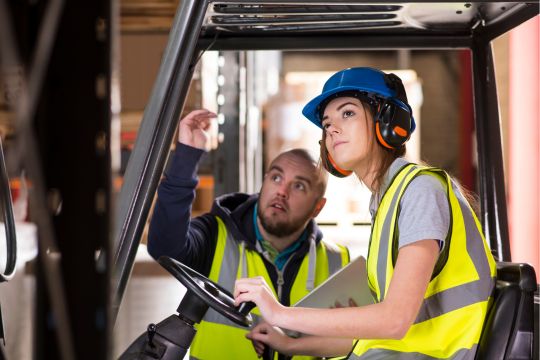
Palletizing is quite possibly one of the most important warehousing and manufacturing operations. How a business palletizes affects the safety of staff and the efficiency of an operation. When pallets are stacked inappropriately, wrapped too little, or stored in hazardous conditions, they are dangerous and may cause broken merchandise, injured employees, and delayed shipments. But when you invest in palletizing safety best practices for workplace efficiency, the same pallets become the cornerstone of a smooth and secure process. You ensure stability, prevent injuries, and maintain production without interruption. Safety is no longer a compliance requirement; it is a competitive advantage because it can increase performance. By emphasizing prevention and control, you save money, limit downtime, and offer consistent results.
Palletizing safety is essential simply because irregular or damaged pallets can lead to disastrous consequences. A broken board, a splintered edge, or a loose nail may not seem bad, but loaded with weight, such minor imperfections can become bigger issues. Reusing defective pallets creates an unstable stack. At the same time, discarded pallets in work zones pose risks and unsafe working conditions for employees.
Complacency in safety does more than endanger workers. It also demotes compliance. Incorrect stacking or over-stacking pallets beyond safe pallet height regulations can result in fire-code and building-code offenses. If pallets are obstructing or blocking aisles, a facility is not only unsafe but also not compliant with OSHA regulation 1910.176 pallet safety, which requires materials to be stacked tightly so as not to slide or collapse, and aisles must remain unobstructed. Palletizing practices, therefore, have a direct influence over whether a facility complies or pays fines.
The connection between safety and productivity is no less critical. Hazardous practices can lead to accidents, reducing production and raising costs. Training, equipment maintenance, and procedure adherence minimize risk and promote uptime. Poor handling techniques and ergonomics are responsible for most palletizing accidents, which redesigned workflows and enhanced equipment can prevent. A safe operation is more productive because employees work confidently, material moves smoothly, and processes are consistent.

Level pallet positioning is at the heart of safety. Pallets must always be flat and never tilted in unstable directions. Loads must be carefully balanced with the heaviest at the base for stability and light materials stacked above them. When stacks exceed the safe pallet heights, the tipping hazard is pronounced, especially when being moved by forklifts over uneven floors.
Two of the most popular stacking methods are employed on a routine basis: column stacking and interlocking stacking. Column stacking is optimum for ultimate vertical strength and can accommodate large loads effectively. Interlocking stacking is more suitable for ultimate lateral stability, restricting side-to-side movement. The decision to use one versus the other depends on what kind of merchandise is being shipped and under what conditions it will be stored or carried. Overhang can be eliminated no matter what pattern is used. Merchandise that extends beyond pallet edges is more prone to damage and compromises the stability of the load in general.
Inspection is equally crucial. Damaged, nailed-out, or compromised pallets should not be recycled. A pallet inspection form streamlines inspections so that unsafe pallets are out of service before becoming an issue. Continuous inspection prevents accidents and improves OSHA pallet safety 1910.176 conformity. Consistency in pallet stacking safety safeguards workers and renders operations dependable.

Even a well-stacked pallet needs containment to stay safe. The most effective pallet wrapping best practices are necessary for load securing when the loads are handled, transported, and stored. Stretch wrap containment pressure provides the pressure that holds boxes secure. When the wrap is applied too loosely, products shift during shipping. When the wrap is over-tightened, the packaging can be dented by pressure. Effective wrapping begins at the pallet floor and moves upwards, overlapping each level to offer thorough coverage.
Some newer palletizers have simultaneous wrapping, where the load is wrapped layer by layer as it is built. This provides instant stability and prevents accidents that can occur with unwrapped stacks. This technology secures loads more safely and assists in workplace productivity by removing extraneous steps.
Load stability suggestions extend beyond wrapping. Spreading the load across the center of the pallet reduces tipping, and stability testing before shipping can prevent massive issues. A slight nudge to ensure movement works well in checking unstable stacks before forklifts or pallet jacks move them. Proper storage of pallets also plays a role. Bundled pallets must be stored only in approved areas and not block exitways or paths. Racking should always include racking safety signage to notify of load capacities and prevent overloading. With wrapping and stability guidelines, you now have safe and reliable pallets protecting employees and products.
Pallets introduce new risks that must be addressed. Forklift safety handling pallets requires compliance with OSHA regulations under CFR 1910.178. Drivers should perform regular checks and respect load weights. Overloading pallets or when the load center is excessively far forward reduces the lifting capacity of a forklift, making it vulnerable to tipping over. Drivers require training to keep pallets centrally located and within an acceptable load weight.
Pallet jacks, though small, are not accident-free. Safe use of pallet jacks involves using them solely for pallets that are too heavy or awkward to be handled manually. Two workers must handle very heavy loads together to avoid getting injured. Blocked aisles impede safe travel and facilitate collisions. Open corridors are essential for both safety and productivity.
Equipment condition matters as well. Forklifts with damaged handles or wheels are unbalanced and must be removed from commission. Racking safety signs help by warning operators of limitations and keeping people accountable. When regulations are heeded, forklift safety and pallet jack operation reduce injury, and product movement remains efficient.
Because palletizing is extremely physically demanding, ergonomics must be the highest priority. Many palletizing accidents result from repetitive lifting, twisting, and bending. Persuading workers to lift heavy loads at awkward heights greatly increases the risk of back damage and musculoskeletal disease. Reducing processes to remove repetitive stress has a significant effect on safety outcomes.
Ergonomic palletizing machinery makes such upgrades possible. Machines such as lift tables, conveyors, and adjustable palletizing stations reduce bending and reaching. By utilizing such machinery, you reduce physical strain and enhance efficiency. Automation can also minimize the risk by executing the heaviest and most repetitive tasks. By allocating these tasks to machines, workers can focus on monitoring, quality control, and problem-solving instead of manual stress.
Training complements these protections. Teaching the proper techniques for lifting with an emphasis on pallet handling equipment usage helps workers avoid injury. Regular reminders to remove compromised pallets and maintain open aisles add to ongoing safety. Training palletizer personnel raises awareness. It encourages prudence, making it possible to identify risks before they cause damage. Combining ergonomic improvement with training keeps workers safe while boosting facility capacity.

Technology has transformed palletizing. Robotic palletizing reduces manual handling to a minimum, preventing repetitive stress disorders and accidents from heavy lifting. Automated palletizing safety delivers uniformity in stacking and wrapping, preventing variations destabilizing the load.
Safety features are incorporated in modern-day machines. Palletizer guarding requirements demand protection such as light curtains, cages, and double protection that safeguard operators from injury. Computerized wrapping methods, such as layer-by-layer containment, hold loads in place during the building process, minimizing instability. Safe distances around palletizers are also needed. Operators must be cautious in respecting barriers and employing lockout/tagout procedures for maintenance.
Technology also enhances tracking. Tracking pallets gives you visibility into the life of every pallet, from stacking to storage and shipping. Tracking reduces lost loads and creates data records that help you find risks and inefficiencies. This data allows you to enhance processes, enhance safety, and validate accuracy.
Although automation minimizes hazards, it does not leave training and consciousness out of the picture. Operators must know how to safely interact with the machines and be ready to step in when necessary. When you integrate robotic palletizing with training and routine checks, you have a balanced system where technology and labor cooperate to provide safety and efficiency.
Safety when palletizing requires constant watchfulness. Crushed or pallets with nails missing must be removed from service immediately. Passageways must be kept open to prevent tripping and collisions. Safe pallet storage must meet fire codes and building regulations to protect facilities and personnel.
The condition of the pallet is only one aspect of hazard analysis for palletizing. Stacking patterns, wrapping techniques, forklift usage, and racking stability must all be analyzed. A warehouse inspection checklist standardizes the inspections and ensures that no detail is neglected. A pallet inspection checklist also ensures consistency and removes unsafe pallets from circulation.
Regular monitoring also increases accountability. Managers are responsible for complying with pallet height safety requirements, reviewing stretch wrap containment force, and inspecting forklift operators' certifications. Documentation of these inspections proves compliance during audits and encourages a culture of constant vigilance. Ongoing review ensures that safety protocols are updated and that new equipment, processes, and risks are adapted.

The best way to sustain palletizing safety is to make it part of the work culture. Safety cannot simply be written policy; it must become how the staff operates daily. Workers must be rewarded for reporting hazards and empowered to act when they see unsafe behavior. Managers and supervisors support this culture by consistently showing safe behavior and responding to risks as soon as they are identified.
Training builds such a stable work culture over time. Instead of just training palletizer operators, staff members should be aware of the machinery and the protective measures that safeguard them. Even simple rules, like removing faulty pallets or compliance with safe pallet height limits, must be made mandatory until they become second nature. Worker acceptance is higher when training is repeated regularly and associated with concrete rewards.
The culture should also connect safety with performance. When workers see that palletizing safety prevents injuries and improves productivity, they become more invested in maintaining standards. Over time, palletizing safety best practices for workplace efficiency become part of the business's identity rather than just a compliance measure. A strong work culture ensures that safety remains a priority even under pressure.
Compliance with OSHA is just the starting point. Continuous improvement ensures safety practices keep pace with new challenges. Regular audits on palletizing equipment ensure safety features are functioning. Investigating incidents and near-misses identifies trends that can be addressed before they lead to catastrophic accidents. When you utilize pallet tracking, you also increase efficiency and safety by using data to increase visibility and accuracy.
Improvement may entail the adoption of new technology in addition to palletizing safety best practices for workplace efficiency in everyday operations. The containment force of stretch wrap should be regularly inspected to verify that loads remain stable. Safe zones around palletizers should be implemented through signs and training. Pallet load weight capacity should be complied with, with regular checks to determine conformity. Through these sustained efforts, the facility should remain ahead of problems rather than responding after issues have been encountered.
Consider how you want to present your business to customers to extend your commitment to educating them about essential safety practices. Learn more about pallet business website design services that will help you emphasize your dedication to safety, efficiency, and professionalism.